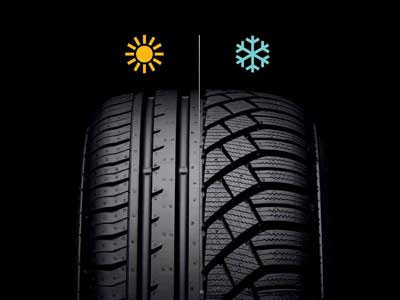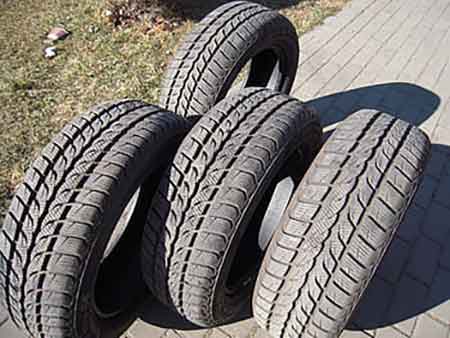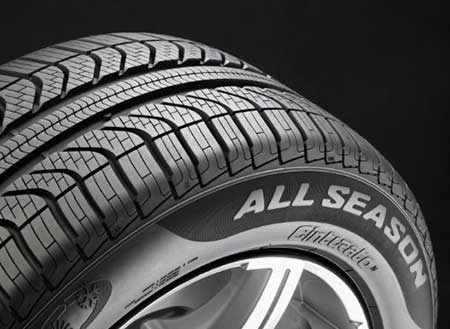The use of winter tires in summer is not regulated by law. Therefore, you are not legally obliged to have summer tires fitted during the hot period of the year. Many people say that they are not really necessary, that you can do your job with the winter ones, that there is no point in giving more money. Al of this is wrong
The reality is that using winter tires in summer is both dangerous and financially expensive.
Contents
What happens if we use winter tires in summer?
Winter tires have a much harder and denser composition than summer tires. They are made to become softer at lower temperatures and harder when it is warm outside. This means that if you go with them during the summer, they will be much stiffer than you should.
The situation will entail a much greater braking distance than normal, and the grip is also much lower. You will see trepidations in curves, even skids if you use winter tires in summer.
Unfortunately, there is an extremely high percentage of over 15% of the car fleet that runs in summer with winter tires. It seems that this percentage has increased in the last years because the drivers bought winter tires being obliged by law, but being too comfortable or because of having money issues, they did not have a set of dedicated summer tires for the warm season.
So the only solution found was to drive all year with the same set of winter tires, regardless of consequences. If you look at the cars in traffic, you will see that the number of those with winter tires in summer is increasing.
I saw at the traffic lights BMW X5, Jaguar, Mercedes-Benz new models or Range Rover, which were still fitted with winter tires. Even taxis, vans, commercial or private cars. So one thing is clear regardless of the car or status, few are bothered to buy new summer tires.
Why people don’t buy summer tires anymore?
The tire market dedicated to the hot season has been declining in recent years. And this has two reasons: either the driver has no money because he has already invested the budget on a winter set, scared of the fine by law, or he has a used winter set that he will replace in winter, so he uses it in the summer, to save money …
The financial situation is the reason why some do not equip their car with special tires for each season. And this is a bad habit. Namely to put the savings above your safety and those around you. Because the reality is that using winter tires in summer is not only more dangerous but more expensive for the driver.
Why using winter tires is not safe in the summertime?

The first thing to keep in mind is that a winter tire is made to work when it is cold. More precisely, when the outside temperature is less than 7 degrees Celsius (44.6°F). The higher the temperature, the more the tire will harden.
The chemical compound from which a tire is made differs greatly from summer to winter. The one on which the word “Winter” is printed, the one with that mountain sign and snowflake, is from a compound that preserves its elasticity in cold weather. Instead, it strengthens and becomes even rigid as a stone, when the temperature is high.
Increased braking distance.
Studies have shown that a winter tire brakes a car when it is 30 degrees C (86 ° F) 2.5 meters further than a summer tire. Things get even worse when you try to brake the car when it’s hot outside on wet asphalt. A winter tire in these conditions stopped the car, compared to one equipped with summer tires, at a distance of about 2 car lengths. Just like if you want to brake in winter with summer tires. Things are the other way around.
Winter tires are heavier.
This is a normal thing, being more profiled, having more material. But you’ll realize it at high speed. And, being summer, being warm, the chances of traveling at maximum speed on the highway are much higher than the cold season when you are calmer, because of snow or pole on the road.
With winter tires you lose grip in summer.

As I said above, the material from which the tire is made becomes extremely rigid in the heat. Usually, the tire works on the asphalt by rubbing, the profile being better fitted to the tread surface. However, if the tire is as rigid as the stone, the friction will no longer be efficient. Think about going on the tiles with some elegant shoes that have a solid sole. Suddenly stop running and you will hit the ground. Try on some running shoes, with a soft sole, and you will be standing. So is the tire.
Winter tires increase the chances of car aquaplaning in summer.
Again, the truth. Because the winter tire profile is specially designed for ice and snow. The winter tire fails to evacuate the water from the asphalt as fast as a summer one, so the risk of aquaplaning is present from a low speed. Again, a huge accident risk that can be easily avoided.
Winter tires are at higher risk of a blowout in summer.
It sounds dramatic, no?. As I said above, it is clear that winter tires were not made for high temperatures. Many people do not know that, on the road, from friction with air and with asphalt, the tire reaches temperatures even higher than 50 degrees C (122°F).
As I said, the tire heats up enormously from the heat emanating from the friction with the air and asphalt. And the higher the speed, the higher the temperature. But one thing is to travel when it is winter and the tire cools, and another thing is to travel when outside is 35 degrees (95°F) and the asphalt is somewhere around 60 degrees C (140°F). The summer tire withstands such temperatures because it was designed to.
In contrast, the winter tire is not good at it. The sidewalls of winter tires, when the temperature is higher than the one they were made to withstand, begin to crack. You should also know that most of the tires blow out on the highways are winter tires that have given up because of the excessive heat.
And last, but not the last reason, is that you throw your money out the window. When it’s warm, the winter tire gets stiffer. But with all this, it wears off a lot faster. Do a test if you have something like this in the car, stand up and turn the steering wheel several times left and right. Under the tires, you will see a thin layer of rubber.
Even if the profile wears out faster, about 2mm in summer when driving daily, the compromised part is different. Namely the edges of the blocks in the profile. Those outer edges that define a winter tire and help you get out of the snow and break in the ice efficiently. If the corners of the blocks were rounded off from the warm weather, on the hot asphalt … Next winter, those tires would be good to just throw them away
What about all-season tires?

It should not be overlooked that all-season tires are a compromise and will not have the same performance in winter conditions as a specialized winter tire and also will not exhibit the same behavior as a summer tire, under conditions. summer.
All season tires are for those who do not travel very many kilometers and do not travel in difficult winter conditions. Also, the price of a set of all season tires is about half, compared to the price of two specialized tire sets (winter and summer), which in the short term is a more friendly version with the protofel, but it must be taken into account that mixed tires will wear faster.
Conclusion
The tests carried out indicated the existence of an important difference in performance between summer and winter tires in terms of braking and handling in hot weather. The variations can be between 30% and 8%, depending on the conditions of the road and the temperature.
In humid weather and a temperature of almost 30 ° C (86°F), a vehicle equipped with good quality summer tires has a braking distance of 30% less than a vehicle equipped with winter tires. Under certain conditions, the difference can even be twice the length of the car, say Bridgestone specialists.
